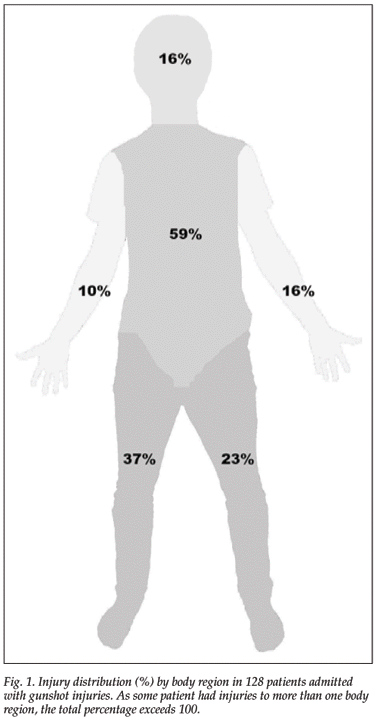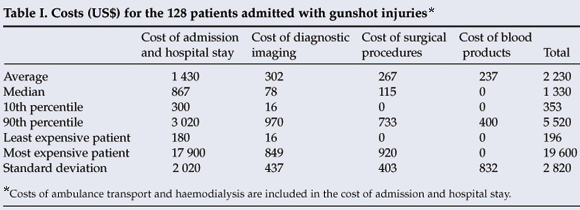Serviços Personalizados
Artigo
Indicadores
Links relacionados
-
 Citado por Google
Citado por Google -
 Similares em Google
Similares em Google
Compartilhar
SAMJ: South African Medical Journal
versão On-line ISSN 2078-5135
versão impressa ISSN 0256-9574
SAMJ, S. Afr. med. j. vol.99 no.6 Pretoria Jun. 2009
SCIENTIFIC LETTERS
The costs of a bullet – inpatient costs of firearm injuries in South Africa
Johannes NorbergI; Tomas NilssonI; Anders ErikssonII, *; Timothy HardcastleIII
IBM, Section of Forensic Medicine, Umeå University, PO Box 7616, SE-907 12Umeå, Sweden
IIMD, PhD, Section of Forensic Medicine, Umeå University, PO Box 7616, SE-907 12Umeå, Sweden
IIIMB ChB, MMed, FCS (SA), Trauma Department, Tygerberg Hospital and Stellenbosch University, Tygerberg, W Cape (current affiliation: Trauma Unit and Trauma ICU, Inkosi Albert Luthuli Central Hospital, Durban)
To the Editor: South Africa has a reputation for being a violent society, with non-natural causes of death estimated to account for up to 30% of all deaths. Among these, firearm injuries are a common cause of mortality.1,2 In addition, about 127 000 individuals are treated at South African state hospitals each year for non-fatal firearm injuries.3 A previous study examined the cost of treating serious abdominal gunshot wounds in a district hospital and showed that each bullet cost taxpayers the equivalent of US$1 467.3
Aim and methods
Our study was performed with a similar goal to that of Burch and Allard (to determine the average cost per bullet to the health care system), but we also attempted to review a broader cost perspective at the Tygerberg tertiary teaching public hospital situated in Cape Town. We applied a retrospective methodology, using a convenience sample over the last 3 months of 2006, with a number of distinct differences: we included all patients with firearm-related injuries (identified by the International Classification of Diseases (ICD) code) who required admission >12 hours, to exclude very minor injuries and those for whom care was futile, while attempting to effectively cost the real expenses of care, excluding staff salaries and laboratory and pharmacy costs. The study was approved by the Ethics Committee of Tygerberg Hospital and Umeå University.
Parameters recorded included demographics, duration of time in general ward and in intensive care unit (ICU), diagnostic imaging, time of surgery and anaesthesia, quantity and type of blood products used, ambulance transport, haemodialysis, anatomical location and severity of the injury sustained, by means of the Abbreviated Injury Scale (AIS).4
The main differences between our and the Burch study3 were the modalities utilised for the actual costing of treatment in a general ward and/or ICU and the cost of diagnostic imaging, which was calculated using the Uniform Patient Fee Schedule (UPFS) (personal communication, Brenda Williams, Tygerberg Hospital). The costs of surgical and anaesthetic procedures were calculated using the National Health Reference Price List (NHRPL), the costs of blood products using the price list issued by Western Cape Blood Transfusion Services, and ambulance cost from the price list of Western Cape Metro Emergency Medical Services (EMS) (personal communication, Dr Cleeve Robertson, EMS Director).5,6 All costs were calculated using the most recent versions of the price lists. The costs in South African rands (ZAR) were converted to US dollars, using mid-market rates from 31 December 2006.7 The method of calculating costs was partly adopted from Allard3 as well as from Berman et al.8
Findings
One hundred and twenty-eight (63%) out of 203 gunshot victims were admitted for >12 hours. The mortality in the former group was 6 patients. Young adult males predominated (87%), with an average age of 28 years. Most (89%) were unmarried. Most patients presented between 7 p.m. and 7 a.m., and mostly over weekends.
The average length of stay was 5.8 days; during the study period, 0.6 % of all beds (78 beds) were occupied by patients with gunshot injuries. ICU admission averaging 2.7 days was required for 28% of the cohort. Most patients (95%) underwent diagnostic imaging, and 49 (38%) required surgical procedures in theatre. Blood products were given to 21 patients (16%). The injury severity score (ISS) was calculated to average 8.0 (median 8.5, range 1 - 34).
The distribution of bullet entry wounds is shown in Fig. 1. The average inpatient cost per day was $US385, and the average cost per patient was $US2 230. The range of costs per patient was $US196 - 19 600, and the total cost for the 3 study months was $US285 824 (Table I). The greatest costs were those of admission and duration of general ward and ICU stay, including ambulance transport and haemodialysis (64% of the total cost for all patients), followed by diagnostic imaging (14%), surgical procedures (12%), and blood products (11%) (Table I). Importantly, these figures exclude the costs of staff salaries and laboratory and pharmacy costs.


Discussion
This study gives an estimate of the minimum inpatient cost for treating gunshot injuries, and provides victim demographics and severity of injuries, at a tertiary hospital in South Africa. Most patients with a gunshot injury who were admitted for more than 12 hours were seriously injured (mean abbreviated injury scale (AIS) 3). On average, each patient cost the state health service a minimum of $US2 230. Given that, in 2006, 793 patients presented to Tygerberg Hospital with gunshot injuries (data on file – Trauma Service, University of Stellenbosch) and assuming that the percentage of all patients who were admitted for more than 12 hours was the same as that during the study period, 498 patients with gunshot injuries were admitted for >12 hours, which implies a total cost of $US1 110 000 for treating gunshot injuries at this hospital in 2006.
Allard and Burch studied 21 cases of serious abdominal firearm-related injuries in Cape Town, using a similar methodology.3 They found an average length of hospital stay of 6.5 days, and an average inpatient cost of $US1 467. The distribution of costs was different, however. In their study, the highest costs were for hospital stay, followed by operating theatre, therapeutics and blood products, laboratory services and imaging. The selection of patients was different, since only patients requiring an emergency laparotomy were included; consequently, the need – and therefore the cost – for diagnostic imaging was lower, but the cost for surgical procedures and blood products was higher.
Our study, however, included only firearm injuries that required admission for >12 hours, which may have created certain limitations. The cost estimate also excluded several other costs. The cost parameters included were accessible for retrieval and calculation, and large enough to significantly influence health care expenditure. Among the excluded costs were those for pharmaceuticals, laboratory services and staff salaries. These would have added significantly to the total, but we were unable to retrieve them. The reference costs also represent an average cost for each specific procedure or unit and do not necessarily represent the real cost to the hospital.
On the public expenditure level, increased health care and judicial system costs in combination with loss of productivity and income tax, are also a consequence of firearm-related injuries.8
Conclusion
Gunshot injuries are a heavy workload for state hospitals treating trauma. Several studies have also recognised that such injuries are more expensive to treat than blunt implement and stab wounds. A national costing initiative, utilising a standardised costing system, is urgently required to efficiently determine the real costs of trauma to South Africa's already under-resourced health system.
We thank Ms Zelda Houlie, the personnel of the Tygerberg Hospital medical records department, P O Bylund, Asta Strandberg and Ms Brenda Williams for their valuable technical assistance. We also gratefully acknowledge the financial support received for our study from the Swedish Mission Council and the Swedish Fellowship of Reconciliation.
References
1. Prinsloo M, Seedat M, Kotzenberg C. A Profile of Fatal Injuries in South Africa: 7th Annual Report of the National Injury Mortality Surveillance System (NIMSS). Cape Town: South African Medical Research Council, 2005. www.sahealthinfo.org.za/violence/nimss.htm (accessed 7 September 2008). [ Links ]
2. Anderson BA, Phillips HE. Adult Mortality (Age 15-64) Based on Death Notification Data in South Africa: 1997-2004. Report No. 03-09-05. Pretoria: Statistics South Africa, 2006. http://www.statssa.gov.za/publications/Report-03-09-05/Report-03-09-052004.pdf (accessed 7 September 2008). [ Links ]
3. Allard D, Burch VC. The cost of treating serious abdominal firearm-related injuries in South Africa. S Afr Med J 2005; 95: 591-594. [ Links ]
4. Committee on Injury Scaling. The Abbreviated Injury Scale. Revision. Des Plaines, IL: Association for the Advancement of Automotive Medicine, 2005. [ Links ]
5. Council for Medical Schemes. National Health Reference Price List, 2006. Pretoria: Council for Medical Schemes, 2006. www.medicalschemes.com/nrpl/nrplpublications.aspx?CatId=26 (accessed 7 September 2008). [ Links ]
6. Western Cape Blood Transfusion Services, 2006. www.wpbtsmedical.org.za/images/2006_PAWCPrice.pdf (accessed 7 September 2008). [ Links ]
7. Oanda Corporation, 2007. www.oanda.com/ (accessed 7 September 2008) [ Links ]
8. Berman EG, Krause K, McDonald G. Small Arms Survey 2006; Unfinished Business. Geneva: Oxford University Press, 2006: 189-213. [ Links ]
Accepted 2 December 2008.
* Corresponding author: A Eriksson (anders.eriksson@rmv.se)














